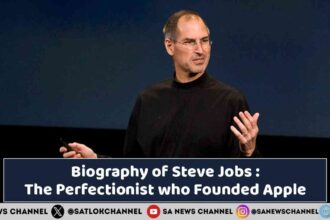Leonardo da Vinci, born on April 15, 1452, in the small town of Vinci in Tuscany, Italy, is often hailed as the archetype of the Renaissance man—an individual whose interests and expertise span a wide array of disciplines. Leonardo’s legacy as a painter is universally recognized, with masterpieces such as The Last Supper and Mona Lisa earning him a permanent place in the annals of art history. However, to confine his genius to just his artistic achievements would be to do a great disservice to one of history’s most multifaceted individuals.
Leonardo da Vinci Early Life and Education
Leonardo was born to an unmarried Florentine notary, Ser Piero and a peasant woman named Caterina. Bearing his illegitimate status however, Leonardo was brought up in the home of his father where he could go through motion pictures; converse with scholarly people and complete top notch education. He had been born with a ravenous desire to understand the world from almost as early he was able to remember, and it would mark every moment of his life—and work.
Leonardo was apprenticed to Verrocchio when he was 14, Leonardo perfected his abilities in painting, sculpture and mechanical arts under the teachings of Verrocchio. Here Leonardo started out to evolve his actual style – based in very deep statement with a definite leaning against the mechanisms of Nature.
Artistic Contributions
Even though not many pieces of art has been made by Leonardo, he has managed to evoke feelings in people like no one else. He is the one who makes it possible for viewers to enjoy works with such consistency and high-quality attention to detail and depth and has the most masterful knowledge of form. The Last Supper, painted by Leonardo da Vinci in between 1495 and 1498, is depicted in this article as an image.
Leonardo da Vinci: Not sure if this fresco is the same as the one you mentioned in your last post, but after the last supper, they are each handling their emotions at a long table; he tells them one of his disciples will betray him.
■ Also Read: Isaac Newton: The Architect of Classical Physics
Leonardo’s non-fresco mid tempera did not necessarily have the experimental background that he first intended it to be an artwork that can be performed in a short period and longer than normal fresco painting at the time, but that’s still a lot of reason for his staying as one of the important people in history Art. This is still one of the most famous compositions in the world. widely accepted even after the restoration.
The Mona Lisa is probably the most famous painting to be in existence anywhere. This portrait, carried out in the first half of the 16th century of a woman with a withdrawn smile is one that has bewitched the viewers for a long time. Such captivating qualities of the work of art are not limited to that. The woman has that ambiguous appearance.
Industries and Technology
In addition to his extensive collection of artwork, Leonardo da Vinci was a fervent scientist and inventor as well — truly embodying the spirit of the Renaissance man who combined art with science. He maintained journals covering a range of subjects including anatomy, engineering, botany and even physics filled with sketches observations an notes.
His surgical dissections of human corpses resulted in highly detailed illustrations long before they could be printed with in fact, advancing the contemporary knowledge about physiology greatly. His anatomical studies, such as the world-renowned Vitruvian Man, showed not only his acute observational aptitude but also confidence in mutuality of art and science.
Leonardo da Vinci” As deep rooted as Leonardo was in the arts, his sense of mechanics and engineering fascinated him no less. At the time, he made drawings of design for scores machinery that are today precedents to contemporary inventions. He is best known for his conceptual designs of flying machines, including the ornithopter (a machine that flies by flapping its wings). Although they were never executed during his lifetime, the designs demonstrated an advanced understanding of aerodynamics and mechanics.
At the same time, his sketches for war machines like tanks and canons also highlight this aspect of him pioneering new ways to use technology in order to solve everyday problems.
Quibbles from a Philosophical and Ethical Standpoint
This was more aligned with the humanist philosophies recurrent in Renaissance and became a work based on observation and experience, much as Geometry is today. He insisted that knowledge could only be obtained through personal observation and experimentation as contrary to depending entirely on classical texts or established dogma. This was a revolutionary empirical method, which would inspire later scientists and artists.
In addition, Leonardo’s notebooks provides insight into his reflections on even more profound ethical and philosophical issues. His work explored aspects that pertained to life and death, the ethical rightness or wrongness of human decisions concerning natural resources, as well as matters related to man against nature.
Leonardo da Vinci Legacy
Leonardo da Vinci breathed his last on May 2, 1519, in Amboise, France, and left behind a legacy that still inspires artists, scientists, and thinkers around the globe. His ability to connect art and science, along with his insatiable curiosity and thirst for knowledge, make him a person who stands beyond time in human history. The diversity of his interests and accomplishments is the true essence of the Renaissance, which is the period of time when classical learning was revived and intellectual exploration was pursued. Leonardo da Vinci’s life and work are still vivid illustrations of the immense power of human creativity that is ignited by the desire to explore and the hard work of understanding the world.
Science, Art, And Technology Will Perish
Science, art, and technology, no matter how advanced, will eventually perish. This world is transient, and everything connected to it will inevitably fade away. Fame and obscurity are fleeting; in the end, death is certain, and everyone will face it. When that time comes, no art, science, or technological advancement can offer salvation.
The only path to eternal life, happiness, and health is through true devotion—Sadbhakti—and returning to the eternal place, Satlok. But how can one achieve this? The key is to receive initiation from a Tatvadarshi Saint, a true spiritual leader whose deeds and teachings align with the scriptures.
In a world where many claim to be saints, how can one recognize a Tatvadarshi Saint? It is the one whose actions and teachings perfectly match the holy scriptures, who imparts the Bhakti mantra according to the Shastras, and who deciphers spiritual truths. Today, there is only one such Tatvadarshi Saint: Saint Rampal Ji Maharaj.
His followers span the globe, and his teachings are accessible to all age groups in simple language. To learn more, one can order the book “Gyan Ganga” for free or watch his Satsang on Sadhna TV channel at 7:30 PM daily.Leonardo Da Vinci: The Quintessential Renaissance Man









